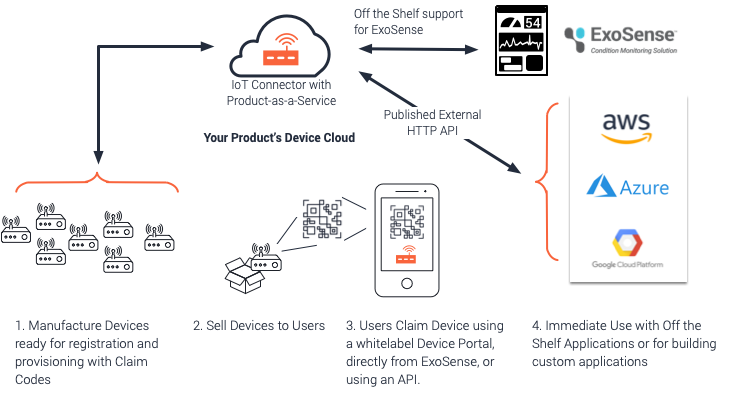EveryCloud™️¶
DEPRECATED FUNCTIONALITY
This functionality and solution template has been deprecated. Please contact Exosite support for information on alternative methods for attaining the features and functionality of the EveryCloud solution on Murano.

Overview¶
IoT Connectors with Product-as-a-Service (PDaaS) technology allows device OEMs to publish an administrative-free Device Cloud that includes an API and user portal website for device purchasers to register devices and begin using connected data.
- Device Claiming - Support for user registration via a claim code and QR Code scanning integration into web applications, including ExoSense.
- End User Device Self-Registration Portal - A branded and configurable Web Application for end-users to register and claim devices and manage device API application linkages
- ExoSense Integration Ready - Out of the box support for device data integration to Exosite's ExoSense Application
- Device Cloud API - Out of the box external HTTP API for allowing customers to build fully custom applications with device generated data
Multi-Tenancy¶
The main capability of a PDaaS Connector is to support multi-tenancy for the Device Maker (OEM). They can create one service that can be used to many applications (within Exosite or with third-party applications and platforms). Device owners 'claim' their device(s) and are able to decide where to use this device data.

As a noticeable value, multi-tenancy enables a single point of management for the Device Maker to manage the fleet a device along with firmware management and OTA.
Device Registration Portal¶
Each PDaaS Connector provides a portal website for customers to discover, claim and interact with acquired devices of the expose product line. This website is externally visible and search engines will index the site, providing an excellent landing page for the OEM/VAR’s technical product marketing person to expand on the product’s connected capabilities. In addition to the marketing messaging on the micro-site, the site is also a functional portal customers can use to claim their device and connect it to the cloud of their choice.
This portal site can be fully branded within minutes making a transparent experience for the users. Full customization is also possible.
Learn more about branding on the publisher management page and portal features on the Device Owner page.
Applications¶
As a multi-tenant service, the device registration portal enables each user to register their own IoT enabled application(s) for device management, remote monitoring, or end-user applications. This creates a data flow integration controlled by the device owner.

Application can be hosted on Exosite's Murano platform, such as ExoSense, or externally hosted applications using a RESTful HTTP API. Read more on the Device Owner application integration guide.
Claim of Ownership¶
When a user acquires a device from the publisher, a digital ownership transfer needs to be executed so the systems can link a device with its owner.
This is done with a claim code, which is provided along with the device purchase, granting a user the digital ownership. Once the claim code is provided to the IoT Connector Portal or an application that natively supports this claiming function, the device is made visible for the device owner in the specific application(s). For ease of use the claim code can be also provided as a QR code which can be scanned from a mobile device.
Find out how:
- Users claim devices using the claim code
- Publisher defines & manages claim codes
Personas¶
Device Owner¶
The Device Owner (Typically the End-User) is the persona having physical access to the device and benefit from its operation. Typically the device owner no mean to change the device firmware and connectivity settings, which would be managed by OEM (the Publisher). Some OEMs may open up support for managing the device firmware and configuration through applications.
Through PDaaS functionality, the Device Owner has following capabilities:
- Find ready to use hardware devices on the Exchange IoT-Marketplace
- Claim ownership of a device
- See device status & data
- Define & Connect applications
- Associate Devices to applications
In the case of multi-tenant Application pre-configured by the Publisher the Device Owner can manage device ownership through the App and might not need to access the IoT Connector Portal.
OEM Publisher¶
The Publisher (typically the manufacturer) is the persona connecting devices to the Murano IoT Connector.
- Claiming management
- IoT-Connector Portal branding
- Provide Managed Application
- Ability to Publish on the Exchange Marketplace
Marketplace Ready¶
With the multi-tenancy capability, a PDaaS Connector can be published on the Exchange IoT-Marketplace to be included in an Off-the-Shelf IIoT Bundle.
Every IoT Connector created with Product as a Service technology can be listed in the Exosite IoT Marketplace (Exchange) as an “Off the Shelf” IoT Connector device service.
This immediately provides two things to the OEM/VAR:
- Visual listing in the Marketplace: a card, along with detailed “where to buy” and documentation information, can be created, and tags applied, so that the Product will be visible to all customers visiting Exosite’s IoT Marketplace.
- Application-specific listings: if the product is usable in a specific industry, and a case study created showing its use with Exosite software, Exosite support can apply a tag for that industry so that customers filtering results by application will see the product as part of their search results

For products that are useful in a target market that Exosite also publishes an Off-the-Shelf IIoT Bundle, the product is eligible for consideration to be included as part of the native bundle. This means that customers who purchase the bundle, or who investigate what is included in the bundle, will be able to use the device with zero additional configuration or setup.